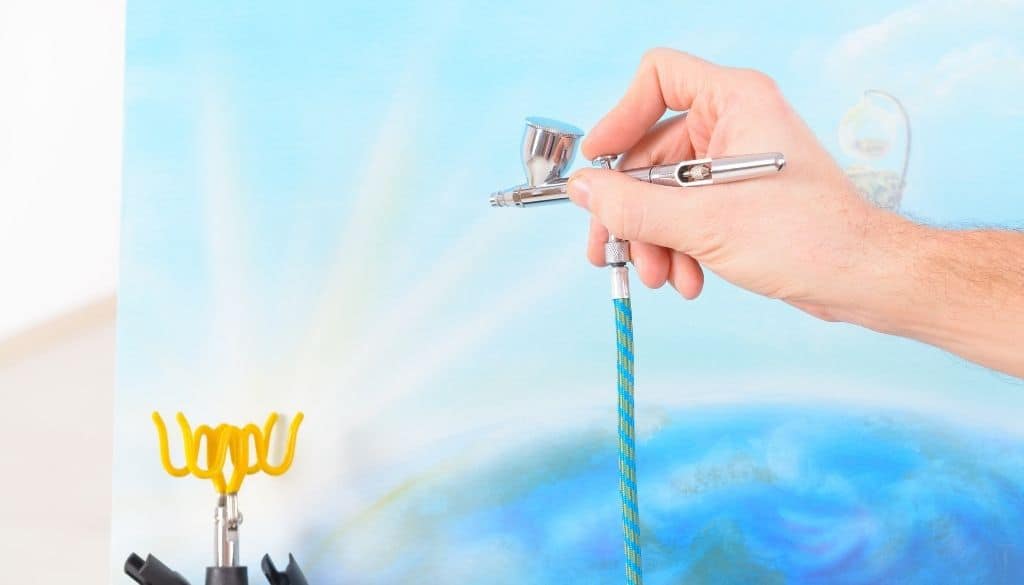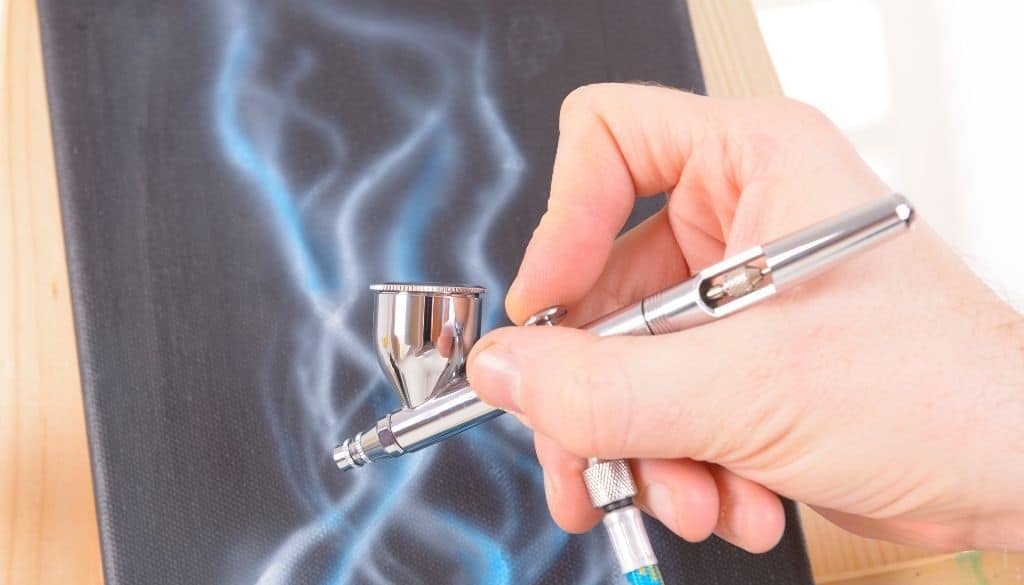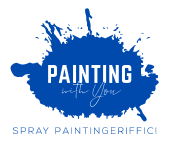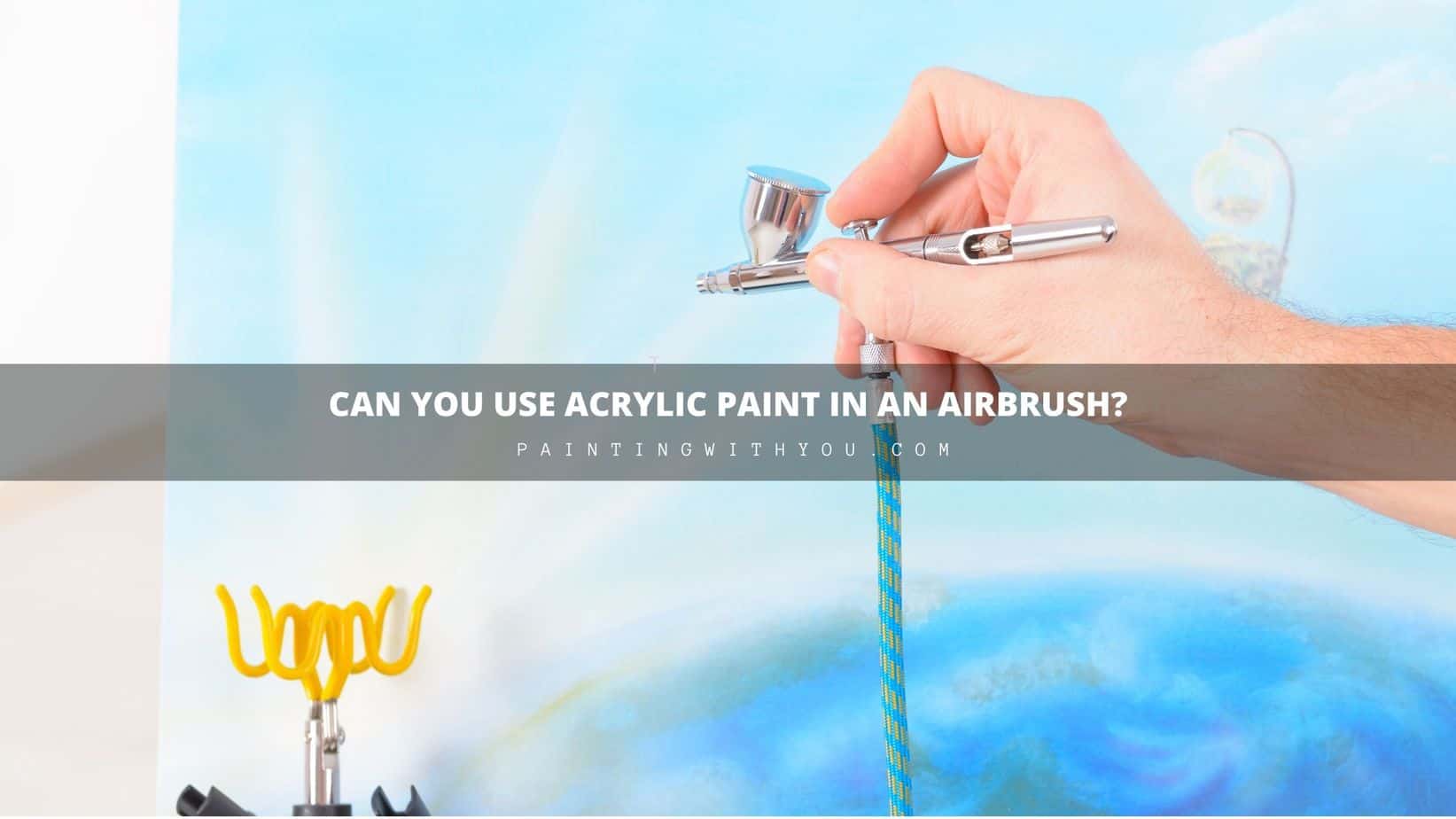Acrylic paint has become a staple for many artists since its debut in the 1950s.
Artists have since used acrylic paint on their own while also finding genius ways to mix this medium with other paint – including airbrush paint.
This type of mixed medium paint requires a few different steps to complete, and prior experience with airbrush paint is advised.

Airbrush came about in 1879 by a man named Abner Peeler. However, airbrush paint did not become a popular paint medium until the 1930s and 1940s.
Two graphic illustrators named George Petty and Alberto Vargas started to use this technique frequently in their work.
In airbrushing, the paint’s consistency needs to be thinned to better spray out of the nozzle, which gives better control of the spray pattern onto whatever surface the artist has chosen.
There are many airbrush products on the market today at specialty art stores, paint stores, special paint manufacturers, and sometimes at your local craft store as well.
Can You Use Regular Acrylic Paint In An Airbrush?
For airbrush paint, acrylic paint straight from the tube will be too thick to be used through the airbrush nozzle.
While airbrushing works through air pressure, which sprays the paint out of the nozzle, it cannot perform this function without a paint around skim milk consistency.
Leaving acrylic paint in its original form will lead to build-up and possibly a malfunction as well. Because of this, the acrylic paint will need to be thinned to the proper viscosity. With a thinner consistency, acrylic paint can easily be used in the airbrush medium.
What Can I Use To Thin Acrylic Paint For Airbrush?
Thinning acrylic paints for airbrushing can be done in a few ways. You can buy acrylic paints already thinned and ready for use to airbrush.
You can purchase traditional acrylic paints or use what you have on hand and use paint thinners to get the right consistency (viscosity).
To thin acrylic paint, you can use specialty paint thinners or household items you may already have – such as the product Windex or isopropyl alcohol.
Liquitex has a professional thinner called “Liquitex Airbrush Medium” that may be ordered on Amazon. Besides Liquitex, Vallejo has a reputable paint thinner product as well. See
NOTE: Paint thinner, color thinner, and paint extenders all do the same job; thin paint as they are solvent-based products. All of these things can be used as airbrush thinners.
How To Do You Thin Acrylic Paint For Airbrush?
To thin paint to use for an airbrush painting, a few steps are involved and vary depending on if you will use a professional paint thinner or household items such as the Windex, water, or isopropyl alcohol.
Thinning With Windex or Rubbing Alcohol
If using Windex to thin the acrylic paint for airbrushing, note that the blue tint will not affect the colors of the paint you are working with.
You can thin the acrylic 2:1 with Windex and 1:1 with rubbing alcohol along with a bit of water if needed and see which better fits your needs for thinning the paint.
TIP: You may also find yourself needing to experiment with the ratios of each fluid. Distilled water or even tap water is commonly used along with rubbing alcohol in the 1:1 ratio when thinning acrylic paint.
Steps involved:
- When using either of these paint-thinning solutions, make sure to wear gloves. Measuring supplies, such as a measuring cup or jars with measuring marks, are needed as well.
- In a medium mixing bowl, add the desired amount of acrylic paint first and then the Windex or rubbing alcohol next, with any water being used.
- If using Windex, double the amount of acrylic paint for a 2:1 ratio. To mix with rubbing alcohol (isopropyl alcohol), add in the acrylic paint and then 25% water and 25% rubbing alcohol. You can use a 1:1 ratio without the distilled water or tap water. Still, it is common for artists to add the distilled water to the thinning mixture as too much alcohol can have adverse effects once the finished painting project is complete.
- If it is still too thick, you can add a bit more water a little at a time.
NOTE: The consistency can vary with homemade thinner, so ready-made solvent-based thinner is popular and easier to use for airbrushing fluid.
With homemade thinner, sometimes the colors of the paints being used can fluctuate due to too much water being added, which will result in a less uniform-looking airbrush artwork.
Using Professional Paint Thinners
For professional thinning products, no other mixing mediums are needed, including distilled water. Everything is already in the bottle, ready for your use. These are all known not to affect the color, unlike homemade thinners.
Each airbrush acrylic medium will have directions on how to mix the thinner with acrylic paints. If there is any question that needs to be answered or information you need, these will have websites that can answer them, with some websites even offering tips.
NOTE: These products may or may not need to be used with a base coat and adhere better to different surfaces than homemade airbrush thinner. When using a professional thinner, an artist may have ease of mind as these are known not to affect the colors of the paints used and are additionally known not to cause a film once the painting is dried, as homemade thinner fluid may be prone to do.

How Do You Achieve The Right Consistency of acrylic paint for airbrush?
Air pressure and the mixed acrylic paints’ right consistency are vital parts to complete good airbrush work – good airbrush techniques and flow are not enough. A lot goes into the thinning process.
You will need to achieve consistency similar to skimmed milk, with the paints not too thin but thin enough to flow through any nozzle size you may find yourself using. The right consistency will vary from paint to paint, and you will need less or more thinning fluid due to which method you use to thin the paints while keeping in mind different color pigments.
Each paint brand will require tweaking to get to the desired consistency because acrylic paints fall into two categories; student and professional.
NOTE: Professional grade acrylic paints will generally need to be thinned more, while student grade acrylic paints may need to be thinned less due to these two different grades having different pigment counts in the colors.
Airbrush Thinner and Paint Thinner, Are They The Same?
Typical multimedia thinner is easily confused with airbrushing thinner – but they are not the same. Multimedia thinner, which you may find more easily, only makes the paints mixed with this type of thinning solution appear more translucent, giving the finished paint the look of transparency in the color once it has dried.
Some artists will try to mix these types of thinner for airbrushing – but they do not end up with the desired effect of airbrush thinner, which thins airbrush acrylic paint to the right consistency for airbrush art.
The paint’s look, once dried, when using the appropriate thinner for airbrushing, will retain the color pigments even though it has been thinned – much like the types of pigments found in watercolor.
What Happens If You Do Not Thin Your Airbrush Paint?
If you do not thin airbrush paints with any thinning mediums, there is a great chance that the paint will be too thick to spray out the nozzle, even with the amount of air pressure that airbrushing is created by.
Hardened particles may stop up the airbrush equipment flow, causing thick blobs to come out on the surface you are painting, or get stuck in the nozzle, which affects the airbrushes flow.
With all of these scenarios, you would then need to use an airbrush cleaner to properly clean the airbrush equipment, taking more time and energy to fix than if the paint was thinned properly in the first place.
With solvent-based paints like acrylic, keeping all this in mind is vital, as paint solvent directly ties to drying time and matters when using airbrush equipment.
To clean the un-thinned paint from the equipment takes a special cleaning solution; regular water may increase the flow, yet there will still be more stuck-on paint on the inside of the nozzle even with a bigger nozzle size being used.
In the world of airbrush artwork, using suitable paints and the correct density through proper thinning will help you go far in the world of airbrushing.
Read next:
- How to protect acrylic painting?
- How to seal acrylic painting?
- How to store paintings?
- Can you use acrylic painting on paper?
- Can you use acrylic paint as nail polish?
- Acrylic painting guide
- Will Acrylic Paint Stick to Spray Paint?
- Best Acrylic Paint for Miniatures
- 20 Ways to Avoid Brush Strokes when Painting Acrylics

